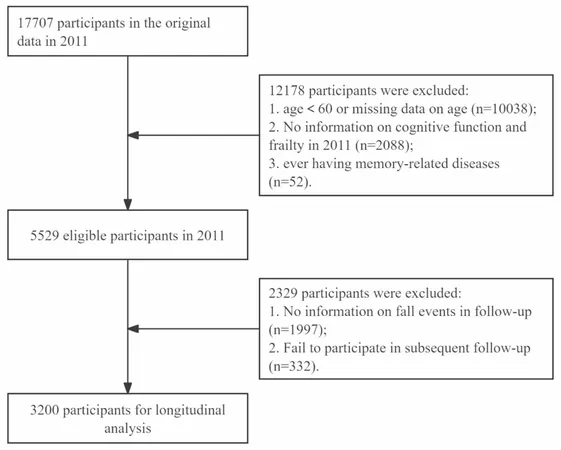
Unveiling the Disturbing Link Between Cognitive Frailty and Falls in China’s Aging Population!
2025-04-05
Author: William
As the global population ages dramatically, China stands out with the largest number of older adults worldwide—an alarming trend that continues to grow. This situation has led to severe challenges for healthcare systems, especially given that falls have become the leading cause of death among those aged 60 and above, placing immense strain on resources.
According to the World Health Organization, falls are defined as unintentional falls resulting in injury or requiring medical attention. In fact, global statistics show that approximately 26.5% of older adults experience falls annually. This figure is even graver in China, where nearly 30%—over 50 million seniors—report falling each year.
In 2013, the emergence of cognitive frailty (CF), described as the combination of physical frailty and cognitive impairment, added more complexity to the health issues faced by seniors. CF can lead to not only disability and a reduced quality of life but also significantly heightens the risk of falls. Studies indicate that individuals with CF have a fall risk that is more than double compared to their healthier counterparts.
Interestingly, researchers have categorized CF into two main types: Reversible Cognitive Frailty (RCF) and Potentially Reversible Cognitive Frailty (PRCF). RCF is characterized by the coexistence of physical frailty and subjective cognitive decline without pronounced cognitive impairment, while PRCF combines physical frailty with mild cognitive impairment (MCI). Yet, despite the urgent need for deeper understanding, research on the relationship between these specific types of cognitive frailty and fall risks remains scarce.
To fill this gap, a recent longitudinal study was launched utilizing data from the China Health and Retirement Longitudinal Study (CHARLS), which actively surveys adults aged 45 and older throughout mainland China. Analyzing data from over 3,200 participants across five waves, researchers sought to assess whether cognitive frailty exacerbates fall risks more than frailty or cognitive impairment alone.
Key findings from the study reveal a shocking correlation: older adults with PRCF and RCF displayed significantly heightened fall risks compared to their healthier peers. In particular, participants classified as having PRCF exhibited a 44% increased risk of falling compared to those in the Healthy group. The implications of these findings are crucial for healthcare providers: early screening for cognitive impairments and frailty might be vital for effective fall prevention strategies among older adults.
While the study illuminates critical connections between cognitive frailty and fall risks, it also faces limitations, including potential recall bias from self-reported data and the absence of certain biological indicators. However, the rigor of its methodology and the robust size of the sample bolster the validity of the findings considerably.
To sum up, as China navigates the rapid aging of its population, understanding and addressing the interplay between cognitive frailty and fall risks will be paramount. Falling is not simply an accident—it might signal deeper cognitive and health-related issues that warrant immediate attention. Therefore, targeted interventions and preventative measures must become a priority to protect this vulnerable demographic from the alarming realities of fall-related injuries and fatalities.
Are you or someone you know at risk? It’s time to take charge of your cognitive health before it leads to unexpected falls. Stay informed, stay safe!









 Brasil (PT)
Brasil (PT)
 Canada (EN)
Canada (EN)
 Chile (ES)
Chile (ES)
 Česko (CS)
Česko (CS)
 대한민국 (KO)
대한민국 (KO)
 España (ES)
España (ES)
 France (FR)
France (FR)
 Hong Kong (EN)
Hong Kong (EN)
 Italia (IT)
Italia (IT)
 日本 (JA)
日本 (JA)
 Magyarország (HU)
Magyarország (HU)
 Norge (NO)
Norge (NO)
 Polska (PL)
Polska (PL)
 Schweiz (DE)
Schweiz (DE)
 Singapore (EN)
Singapore (EN)
 Sverige (SV)
Sverige (SV)
 Suomi (FI)
Suomi (FI)
 Türkiye (TR)
Türkiye (TR)
 الإمارات العربية المتحدة (AR)
الإمارات العربية المتحدة (AR)